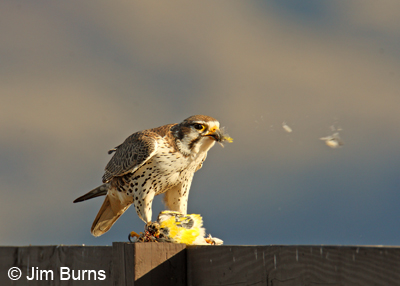
Wes Fritz is driving and I’m riding shotgun, literally I guess, because my 600mm bird lens is hanging out the passenger side window, resting on a rolled up raincoat and supported by my right hand. It’s November in the undulating coastal hills of central California above Solvang, every rise clear to the eastern horizon is waves of tawny golden grasslands, a patch of oaks here and there, and we’re tooling around the mountain curves heading for a known Golden Eagle territory. I’ve been out with Wes before, so I’ve taken a Dramamine before breakfast. The little crystals in my inner ear are still happy on this beautiful autumn morning.
We drop into a steep dip and rise out on a sharp curve. As we top out, going faster than we should of course, the raptor is perched right there, second fencepost on the driver’s side. It’s hard to say which of the three of us is more surprised. Wes grabs the brakes, I grab the lens with both hands, and the bird, mantled over breakfast, hunches even lower, one second from lift off, and glares at us, assessing this fast moving threat. One second later it is airborne, dragging its prey, now obviously a bird because we can see its feet hanging down. It lands again ten posts away. Wes guns the vehicle, thinking if we are moving faster the raptor will stick on this new perch and let us pass, turn around, and approach slowly from the other side, the camera side.
Wishful thinking. The hawk launches immediately and we see the dark axillars. Prairie Falcon. Rowing effortlessly, prey still in tow, the falcon crosses the open field and disappears over a rise. Prairie Falcon trumps Golden Eagle. We drive the area slowly, crisscrossing public ranch roads, scanning ahead for bumps on posts. We top a rise and see the falcon again, 100 yards ahead, on my side, still plucking its hapless prey. For the falcon, breakfast trumps everything.
At fifty yards, the falcon doesn’t care. At thirty yards it looks up, curious now. As we inch closer we begin to see soft, downy feathers wafting down the fence line on the morning breeze that is picking up the Prairie’s hackles. Most are white, some are . . . yellow and black! Wes turns diagonally across the unpaved road and stops. Binocular views confirm the prey to be a meadowlark, its bold chest pattern still beautiful even in its fruitful death.
A runner is coming from the other direction. I guesstimate about thirty seconds to work the camera because, knowing runners, I know he isn’t going to stop. Trying to be calm and smooth, I work the exposure dial with my thumb as I fire away. The Prairie launches again. The oblivious runner doesn’t even see the falcon, but glares at us for blocking the road. As he passes our front bumper, I point the massive lens at his face and hold the shutter button down. Wes is grinning ear to ear. The Prairie has left the county.
Remember when Peregrines were totally endangered by DDT and seeing one was like finding a hen’s tooth? They’re still a great treat for birders, but thanks to their marvelous recovery they’re everywhere now, even breeding on city skyscrapers. I can tell you half a dozen places in the Valley where Peregrines are almost guaranteed in winter, but I couldn’t guarantee you a Prairie if you put a gun in my back. Prairie’s aren’t quite as fast as Peregrines, and they lack the latter’s mythical/legendary cache, but they’re rarer now, and they’re adaptable and smart, known to use landforms to conceal aerial sorties. If you see a Peregrine, you’ve seen North America’s premier avian predator, but if you score a Prairie you’ve seen a raptor that’s hard to find, harder to identify correctly, and hardest to ever see well, right up there in a class with Northern Goshawk and Merlin.